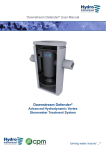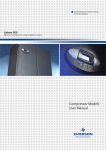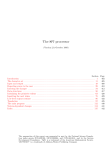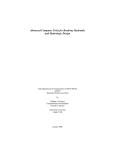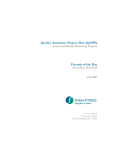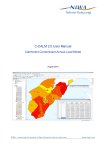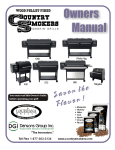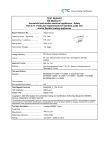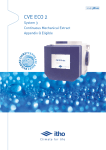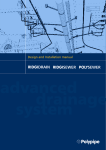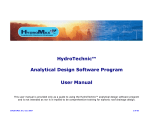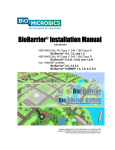Download Stormbloc User Manual
Transcript
Stormbloc® User Manual Stormbloc® Storage & Infiltration System turning water around ...® The Accessible ‘Engineered’ Solution to SUDS SUDS / Source Control Regulatory and guidance documents such as PPS 25 and Building Regulations are putting increasing demands on developers and engineers to consider sustainable drainage systems (SUDS) wherever possible and to incorporate source control approaches into surface water drainage systems. “Sustainable drainage systems (SUDS) are increasingly being used to mitigate the flows and pollution from runoff. The philosophy of SUDS is to replicate as closely as possible the natural drainage from a site before development and to treat runoff to remove pollutants, so reducing the impact on receiving watercourses. This requires a reduction in the rate and volume of runoff from developments, combined with treatment to remove pollutants as close to the source as possible.” 1 1 CIRIA C609 (2004) - Sustainable Drainage Systems - Hydraulic, structural and water quality advice. 2 Integrated Stormwater Systems As with all Hydro’s Stormwater Systems, Stormbloc® and Stormbloc® Inspect can be integrated with or used in place of what are becoming increasingly known as ‘soft’ SUDS solutions (such as swales, ponds, lagoons etc). Hydro International is committed to providing integrated products and solutions that support Sustainable Drainage Systems. In addition to Stormbloc® and Stormbloc® Inspect, Hydro International also provides other solutions for commercial developers and designers. Combined, our products provide comprehensive sustainable solutions to meet the most stringent regulations. Our Stormwater Product Portfolio includes: Stormbloc® Stormwater Storage and Infiltration System Hydro-Brake® Flow Control A block type structure with control that provides superior a patented maintenance hydraulic performance over / inspection tunnel for conventional flow regulators with providing underground patented features that reduce surface water infiltration and maintenance requirements. Our storage systems. STH range of Hydro-Brake®s is A self-activating vortex flow the only BBA Approved vortex flow control. Stormbloc Inspect ® STH Range of Hydro-Brake® Flow Controls A stackable modular access unit offering unrivalled Downstream Defender® accessibility to any An advanced hydrodynamic Stormbloc® installation. vortex separator designed to remove sediment, floatables Stormcell® and Stormcell® Lite Stormwater Storage Systems and associated pollutants from stormwater. A low cost underground storage system suitable for installation beneath roads, car parks and Up-Flo™ Filter amenity areas. Stormcell is A high-rate modular stormwater installed utilising a patented treatment filter featuring a patented pipework system which upward flow path with a unique prevents the entry of silts and Drain Down design. The filter grits into the storage volume. targets a wide range of pollutants ® including floatable debris, fine StormBank® Rainwater Harvester sediments, nutrients, metals, oils and grease, organics and bacteria. The latest addition to the stormwater range of products. The StormBank® can be Save the Rain™ Campaign used to replace treated mains water for use in toilets, Save the Rain™ is a major campaign to make water saving garden and outdoor use. ‘second nature’ in every UK household and protect Britain’s StormBank® Pro for large dwindling water resources. The campaign is being run commercial developments in association with British Water and the UKRHA and is and StormBank® Garden sponsored by Hydro International. (exclusively for garden Visit: www.savetherain.info watering) are also available. 3 Stormbloc® What is it? Stormbloc® is a cellular block type structure used for providing below ground surface water infiltration or storage. The unique advantage of Stormbloc® over other ‘crate’ type systems on the market is the patented inspection / maintenance tunnel through each block offering clear flow paths through the system. This allows for inspection with CCTV cameras, maintenance and cleaning if required. Advantages • Physical Properties Fully accessible for inspection and maintenance Full Block through the patented 222 mm x 570 mm tunnel • within the blocks. Material High void ratio (95%) - high storage volume (an Nominal Block Dimensions (mm) 800 mm x 800 mm x 660 mm block holds 0.401 m3 of stormwater). • Lightweight with high strength. • Zero instances of failure - extensive track record in • including roads and HGV areas. BBA certification pending. • Delivery - generally 1-2 weeks. • Simple and quick to install. • Shallower 350 mm deep blocks available. 800 800 Width 800 800 Depth 660 350 Nominal Block Volume 0.422 m 3 Nominal Storage Capacity per Unit 0.401 m 3 Nominal Block Weight Strong enough to be used under trafficked areas • Polypropylene Length Porosity the UK and Europe. Half Block 0.224 m3 0.213 m3 95% 20 kg 12 kg Ultimate Compressive Strength 330 kN/m2 Short Term Vertical Characteristic Strength (at Yield) 275 kN/m2 Short Term Horizontal Characteristic Strength (at Yield) 100 kN/m2 Long Term Vertical Compressive Strength 80 kN/m2 Structural Testing Stormbloc® has undergone extensive 3rd party structural 660 mm testing and FEA modelling to ensure that it is capable of withstanding the high loading forces that are likely to occur under heavily trafficked areas, as well as long term loading imposed by the ground cover above the system. The modules are manufactured in accordance with m m ISO 9001:2000 and are constantly monitored and tested to 0 ensure that they are free from defects. m 80 800 m 4 Stormbloc® Inspect Stackable Modular Access Unit Unrivalled Accessibility for Stormbloc® Installations Advantages Product Profile The Stormbloc ® • The Stormbloc® Inspect has the same dimensions Inspect offers an unrivalled level as the Stormbloc® modules and is fully stackable. of accessibility to any Stormbloc® installation. This • Can modular access chamber, sited within the tank, has be integrated within all Stormbloc® installations. identical dimensions to a Stormbloc® module and The volume of Stormbloc® Inspect contributes to the • so can easily be incorporated into the layout of the required storage capacity. infiltration or storage system. • Each unit has an ‘inlet’ side for optimum pipe connection into the Stormbloc® installation. Each Stormbloc® Inspect unit offers connection points • High and low level inlet connections possible. on all four sides for direct access to the inspection • Can accept inlet / outlet connections up to 500 mm tunnels on the Stormbloc® modules or for connection internal diameter. of inlet and outlet pipes to the system at any point. • Enables optimum accessibility for inspection and maintenance. • Excellent access to the installation via 500 mm internal diameter extension shaft to ground level. • Reduces need for separate manhole chambers. • The use of a standard vented manhole cover in conjunction with the Stormbloc® Inspect unit removes the need for separate ventilation structures. Extension Shaft 500 mm ID • Reduces installation time. • Reduces capital costs on overall project. Dimension 1 Layer 2 Layers 3 Layers A 950 1610 2270 B 430 1090 1750 Optional Inlet 360° rotation Ventilation 660 mm Upper Inlet Lower Inlet (Pipe Invert Level 45 mm Above Base of Unit) 660 mm A B Inspection Access 800 mm 800 5 mm Stormbloc® Applications Due to its modular nature Stormbloc® can be arranged in any number of configurations for both infiltration and storage. Typical examples include: A large, shallow infiltration or storage blanket (typically 1 block deep, with a minimum depth of 350 mm). An infiltration trench (typically quite narrow and long - depth / length combinations are infinitely variable). A large infiltration or storage structure (typically rectangular or square in plan with depth to suit). An individual soakaway (typically relatively small serving single or small numbers of dwellings). 6 Design Hydro International offers a free outline design service, ensuring the most efficient and cost-effective solution for infiltration / soakaway and storage structures. A further, more detailed Hydrological Analysis service is also available if required. The use of good engineering practice and awareness of the limitations of all materials used will avoid construction and operational problems. Hydro International has an expert and dedicated workforce capable of providing advice on many aspects of system design. Design Steps Summary 1. Storage Volume Calculation Calculation of required storage volume. 2. Location and Layout Selection of the most appropriate location according to loading rates, soil types, adoption constraints and the position of the water table. 3. Depth and Dimensions of the System Identification of the plan area, cross-sectional area, depth to invert and depth of cover. 3.1) Depth of subgrade layer. 3.2) Lateral loadings. 3.3) Depth to base. 3.4) Backfill / cover depth. 3.5) Gradient. 3.6) Flotation. 4. Designing the Stormbloc® Tank 4.1) Stormbloc® modules - selection of the most suitable Stormbloc® sizes and configurations. 4.2) Connection pieces - identification of connection pieces and endplates required. 4.3) End plates and pipe adapters. 4.4) Stormbloc® Inspect modules / access chambers and 4.5) Inlet, outlet and vent pipe requirements. 4.6) Geotextile and membrane protection. upstream catchpits. 7 Detail Design 1. Storage Volume Calculation The system designer needs to calculate the volume of Design Requirements storage required. There are a number of suitable methods that can be used to calculate the storage volume (see references). To be able to carry out storage calculations we require These vary from relatively simple manual methods to sophisticated simulation models. the following, site specific information: As part of Hydro International’s free design service we offer Infiltration Systems 1. Design Return Period drainage modelling software suite: WinDes. 2. Site Location 3. Drained Impermeable Area General design guidance on modelling of Stormbloc® and 4. Soil Infiltration Rate* an estimated storage volume using the industry standard Hydro-Brake Flow Controls can also be found on our ® Storage Systems website: www.hydro-international.biz 1. Design Return Period 2. Site Location 3. Drained Impermeable Area 4. Maximum Allowable Discharge Rate * The soil infiltration rate should be derived from a site porosity test using a recognised method (eg. BRE digest 365). 2. Location and Layout Consider the most appropriate and cost-effective location for the infiltration/storage facility. The flexibility afforded by Stormbloc® combined with the substantial reduction in volume required (when compared with gravel pits for instance) allows the design of storage into locations that would be impractical for traditional systems. Due to the modular nature of the system, Stormbloc® can be assembled to virtually any size, shape, depth or configuration and obstructions such as trees, pipework and rock outcrops can easily be circumvented. Pipe connections can be made from multiple directions into the Stormbloc® system. The use of Stormbloc® Inspect Chambers provides a continuous flow path through the system regardless of changes of flow direction and offers access for inspection / maintenance at critical points (eg. inlet, change of flow direction). The Stormbloc® system can be installed practically anywhere including under roads, footpaths, car parks, public open spaces, landscaped areas, gardens, tennis courts and playing fields. For infiltration systems consideration should be given to the soil conditions of the intended location of the tank. The soil should have a suitable percolation rate (typically > 0.05 m/hr), should be free of contaminants and should not have a high groundwater level. 8 Detail Design 3. Depth and Dimension of the System The Stormbloc® system is highly flexible and allows the system designer to consider a range of options not normally available with other storage systems. There are, however, certain limiting factors that need to be considered: 3.1) Depth of Subgrade Layer The base of the excavation should form a sound working platform and have a sand or gravel subgrade layer to provide a level support base for the system. This should be at least 100 mm deep and be flat and even. Extra care should be given to this subgrade layer for larger installations, and in particular for multilayered designs. 3.2) Lateral Loadings The maximum depth to the base of the units is limited by the lateral (sideways) pressure that acts on the units. This is due to earth and water pressure and the effects of surcharges on the surface. The exact pressure from groundwater should be assessed on a site-by-site basis if groundwater is present above the base of the units. 3.3) Depth to Base If the depth to the base of the system is greater than 3.5 m, please contact Hydro International for specific design assistance. Installation with a depth to base of up to 6 m may be possible under certain conditions. 3.4) Backfill / Cover Stormbloc® should be installed with a minimum depth of cover of 500 mm under landscaped / non-trafficked areas to protect from damage with gardening or agricultural implements. For installations where the system will be subject to loading from traffic the depth of cover should allow the dispersion of surface loading (in particular point loads) such that the loading to the top of the Stormbloc® is distributed evenly and limited to no more than 275 kN/m2 (27 tonnes/m2). The material should be carefully compacted in layers to form a depth to suit the maximum expected loads- please see Sections 11 and 12 for further information. The total mass of ground cover above the modules should not exceed the maximum long term loading limit of 80 kN/m2 (8 tonnes/m2). This equates to up to 3.6 m of stone backfill (maximum density of 2.2 t/m3). As a general guide the following depths of ground cover above the Stormbloc® modules should be adhered to according to the likely traffic loading. Loading Class Minimum Ground Cover Landscaped area with no access for vehicular traffic. 500 mm Car parks, traffic loading < 2.5 t 500 mm Roads and HGV loading yards, traffic loading <44 t 1000 mm The actual loading rate on the modules should always be checked by the system designer. The material used for the construction above the Stormbloc® system should be selected according to the surface loadings. A non-angular granular material (nominally 100 mm thick) should be used immediately next to the geotextile or membrane surrounding the system so as to protect it from puncturing. Alternatively a geotextile fleece may be used. 9 Detail Design 3.5) Gradient Stormbloc® can be laid to a gradient to aid the flow of stormwater through the system. Stormbloc® has, however, been designed and developed to provide resistance to loads applied predominantly in the vertical plane. Laying Stormbloc® to a gradient will therefore slightly reduce the transient and long term loads that the system can withstand. Gradients of 1:100 should generally not be exceeded. 3.6) Flotation If it is necessary to install a Stormbloc® system within the groundwater table then flotation needs to be considered. In simple terms, there needs to be a greater force acting over the system (ie. the weight of the backfill) to compensate for the up-thrust caused by buoyancy. This should be checked by the system designer. If the system is installed within the groundwater table it is advisable that encapsulation of the system is carried out to ensure the system is 100% watertight. Failure to do so could reduce the available storage capacity of the Stormbloc® system. 4. Designing the Stormbloc® Tank The Stormbloc® system comprises of 6 different components: 4.1 Stormbloc® Modules 4.2 Connection Pieces 4.3 End Plates / Pipe Adapters 4.4 Stormbloc® Inspect Modules / Access Chambers and Upstream Catchpits 4.5 Inlet and Outlets 4.6 Geotextiles and Geomembranes 4.1 Stormbloc® Modules The main infiltration or storage tank is comprised Example: of Stormbloc modules in a configuration to suit the If 60 m3 is required then the number of modules to be used can be calculated as follows: 60 ÷ 0.401 = 149.63 150 No. Stormbloc® modules should be used. ® location. A single 0.8 m x 0.8 m x 0.66 m module holds 0.401 m3 of stormwater and so the design should incorporate a sufficient number of modules to provide the required volume. The base layer should be laid directly onto the geotextile or membrane. The blocks should be laid These could be arranged in the configuration: 12 m x 4 m x 1.32 m (15 modules long x 5 modules wide x 2 modules deep) such that the tunnels are in line, creating access through the system. The two available module sizes offer a high level of flexibility in the design and depth of the system. If a combination of full blocks (660 mm deep) and half blocks (350 mm deep) are being used then the half blocks must form the top layer of the system, orientated so that the text imprinted on the half block is at the bottom edge. 10 Detail Design 4.2 Connection Pieces There are three types of connection pieces that are used with the Stormbloc® modules. The number of connection pieces required for single and multi-layered designs are shown in the table below. Single Layer Designs (0.66 m deep modules) Multi-Layer Designs Stormbloc® modules on single layer designs are connected For designs that incorporate more than one layer the with neighbouring rows using only the single layer / multiple layer connector (2) should be used to join the horizontal connecting pieces (1) in the centre of each edge layers in place. that neighbours another module. The horizontal connecting Single Layer Designs (0.35 m Deep Modules) pieces should be laid alternately lengthwise and crosswise For 0.35 m deep Stormbloc® modules in a single layer as shown below. design, the half-block layer connectors (3) should be located in the square openings at the top of the support pillars as shown below. Connectors Connectors Plan View Showing Location of Connectors for (0.66 m deep modules). Plan View Showing Location of Connectors for (0.35 m deep modules). (2) Multiple Layers (3) Single Layer (0.66 m deep modules) (0.35 m deep modules) For installations of one layer of 0.66 m modules. For multiple layer installations. For installations of one layer of 0.35 m modules. On the top surface of the module, in the centre of each edge that neighbours another module. On the top surface of the modules on the lower layer, in the centre of each edge that neighbours another module. In the square pillars on the top plate of the modules. Requirement Application Connector Types (1) Single Layer (0.66 m deep modules) 11 Detail Design 4.3) End Plates and Pipe Adapters All tunnel ends should be covered with an end plate to prevent backfill entering the modules. Where pipe connections are required modified end plates are provided depending on the size of pipe used. Snap-loc End Plates End plates are used where no pipe entry is required into a tunnel. These plates simply snap into position and take seconds to locate 100 to 150 mm ID Pipes If a 100 or 150 mm diameter pipe is used a snap-loc end plate with the appropriate size hole will be provided. A pipe spigot is also provided to ensure a positive connection between the pipe and the Stormbloc® module. Provided that pipe details are confirmed at the time of order these holes will be pre-cut in the end plate prior to arrival on site. 225 mm ID Pipes For 225 mm pipe connections a special adapter plate is required. A flexible pipe coupling will be required to connect the pipe (see page 18 for further information). 150 mm to 500 mm ID Pipes If Stormbloc® Inspects are used then the Stormbloc® system can accept direct connections from 150 to 500 mm ID. 12 Detail Design 4.4) Stormbloc® Inspect Modules / Access Chambers and Upstream Catchpits Stormbloc® Inspect Modules The Stormbloc® Inspect modules can be used in a number of ways to increase the accessibility of the Stormbloc® system and for making inlet and outlet pipe connections. Options i) Inlet and Outlet Connection Points. Stormbloc® Inspect modules can be used as the main connection point for the inlet and outlet pipes. The pipe can be connected at a high or low level using the cut-out sections of the Stormbloc® Inspect modules. The maximum possible inside diameter of the pipes is 500 mm and up to 587 mm outside diameter. ii) Extension Piece The Stormbloc® Inspect modules are supplied with an extension piece to take the inspection chamber up to ground level. A pipe connection can be made directly to this extension piece giving the option of an inlet with a full 360 degree radius. iii) Location Stormbloc® Inspect modules can be installed at any point within the system to give access to the tunnels or to make a pipe connection on the side of the system. iv) Catchpit Receptacle Stormbloc® Inspect modules can be used to form a catchpit receptacle within the system. v) Flow Path Direction Changes in direction of the main flow path can be accommodated using a Stormbloc® Inspect Chamber, allowing a continuous dedicated flow path and access directly to the point of the change of direction. Side Connections Extension Piece Inlet on Extension Piece (360° rotatable) Inlet Connection(s) up to 500 mm ID Low Level Inlet Connection Plan and Section of Stormbloc® System Showing Different Connection Possibilities Using Stormbloc® Inspect 13 Detail Design Catchpits and Inspection / Maintenance Access The Stormbloc® system is directly accessible for maintenance and inspection via the patented access tunnel within each block. Access to these tunnels should be provided from a suitable location on the surface, such as via Stormbloc® Inspect Chambers, manholes or rodding points. Traditional catchpits or silt traps are not very effective at preventing finer particles from entering any system and any trapped material can often be re-entrained during subsequent storm events and passed into the infiltration or storage media. It is, however, still good practice to include catchpits / silt traps prior to any infiltration or storage system. Any chambers or manholes immediately upstream of a Stormbloc® installation should preferably be built as catchpits or silt traps to capture larger or settleable material. Where Stormbloc® Inspect Chambers cannot be used, the manhole chambers adjacent to the Stormbloc® system provide access through the inlet pipes to the tunnels for inspection and maintenance. If required a complete treatment train approach can be provided with the use of the Downstream Defender® and UpFlo™ Filter products which remove a wide range of pollutants including floatable debris, sediments, nutrients, metals, oils, grease organics and bacteria (see below). Downstream Defender® Hydro-Brake® Flow Control Stormbloc® Up-Flo™ Filter Hydro International’s Complete Stormwater Management System 4.5) Inlet, Outlet and Vent Pipe Requirements The size and number of pipes being connected to the system should be sufficient to be able to convey the maximum expected flow rates from the site into the modules without restriction. Typically the inlet pipes (and outlet pipes for an online storage system) will be connected to the lower tunnel on the modules and a vent pipe will be connected to the upper tunnel. Using standard end plates the maximum pipe size that can be connected is 150 mm internal diameter. However, using the 225 mm pipe connector a 225 mm internal diameter pipe can be attached and pipes up to 500 mm internal diameter can be connected via a Stormbloc® Inspect Chamber. Pipes can also be connected to the side of the Stormbloc® modules using the optional cut out piece incorporated into each module. This can accommodate a maximum outside pipe diameter of 180 mm. Provided ventilated covers are used vent pipes allow the system to fill with stormwater without restriction by allowing displaced air to escape through the adjacent access chambers. As a general rule of thumb the number of 100mm diameter vent pipes required should equal the number of inlet pipes entering the Stormbloc® system. If Stormbloc® Inspects are used then vent pipes are not required as the Stormbloc® Inspect modules will allow the system to vent directly to atmosphere again provided ventilated covers are used. 14 Detail Design 4.6) Geotextile and Membrane Protection Depending upon the application, the entire system should be wrapped with either a suitable geotextile (for infiltration) or an impermeable membrane (for storage / attenuation). There is a great degree of variation in the physical properties of available geotextiles and membranes, which should be selected according to specific site conditions. For illustrative purposes some of the key characteristics of typical geotextiles suitable for use with Stormbloc® Infiltration systems are given in the table below. Non-Woven Geotextile Physical Properties for Infiltration Systems Water Permeability (l/s/m2) Minimum * 75 Apparent Opening Size (µm) <110 CBR Puncture Resistance (N) Minimum 1300 Weight (g/m ) 120 2 Note: Figures taken from manufacturer’s data sheet. Potential purchasers / specifiers are advised to check that this information has not been superseded and should satisfy themselves that the chosen geotextile is fit for the intended use. * The geotextile should have a greater permeability than that of the surrounding soil. Impermeable Membrane Physical Properties for Storage / Attenuation Tear Resistance Tensile Strength Elongation at Break Tear Strength (N) ≥20 Tear Strength (N/mm) ≥40 Tensile Strength (N/25 mm) ≥180 Tensile Strength (MPa) ≥14.4 Unaged ≥500% Accelerated Ageing (56 days at 80 °C) ≥250% Density (kg/m3) 920 Note: Figures taken from manufacturer’s data sheet. Potential purchasers / specifiers are advised to check that this information has not been superseded and should satisfy themselves that the chosen geomembrane is fit for the intended use. As a minimum the membrane should be joined using a suitable double-sided jointing tape. For installations where there is a risk of contaminants within the surrounding ground or where the groundwater level is above the base of the system advice on suitable membrane with welded joints should be sought from a specialist supplier (please contact Hydro International directly if you require a list of independent membrane specialists who have previous experience of Stormbloc® installations). 15 Typical Installation Method 1. Transport Stormbloc® is generally delivered with 4 No. 0.66 m or 8 No. 0.35 m deep modules packaged together. The modules should preferably be unloaded with a forklift, telehandler or other suitable lifting equipment. The access tunnels of the lower modules can be used as the lifting points, either by inserting the forks or by fastening with lifting belts or straps. The modules should not be dropped or thrown from vehicles and impacts should be avoided. Each 0.66 m deep module weighs 20 kg, while each 0.35 m deep module weighs 12 kg, making the blocks easy to manhandle. 2. Storage For safety reasons no more than 2 packages (4 No. 0.66 m or 8 No. 0.35 m modules, with a total height of no more than 2.7 m) should be stacked one above the other. In the event of a storm / high winds the modules should be secured and, if possible, not stacked. The modules can be stored outside, however the storage time should be restricted to a maximum of one year. During this time it is recommended that the material should be protected against direct exposure to sunlight (store in the shade or cover with suitable material). It is possible to move the module around the site by hand or with suitable equipment. Before the system is installed the parts should be examined for damage sustained in transit / storage. 3. Excavation The area for the installation should be excavated according to the design. If the maximum depth from finished cover level to the base of the Stormbloc® is greater than 3.5 m structural support to the tank may be required and advice should be sought from Hydro International. Step 1 - Excavation. 4. Sub-Base The base of the excavation should have a sand or gravel subgrade layer. This should be approximately 100 mm deep and be flat and even. Extra care may need to be taken with this subgrade layer for larger installations, particularly for multi-layered designs. Step 2 - Lay sub-base. 16 Typical Installation Method 5. Geotextile / Membrane The entire system is to be wrapped with a suitable geotextile for infiltration applications or a suitable membrane for attenuation systems (please refer to Section 4.6, page 15). Before the modules are installed, the geotextile / membrane should be laid over the subgrade level. The sheet(s) of geotextile / membrane should be large enough such that it can lap over the edge of the modules by at least Step 3 - Lay geotextile / membrane. 200 mm. 6. Stormbloc® Modules and Connections The base layer of modules should be laid onto the geotextile, following the layout as shown on the design. They should be laid such that the inspection tunnels are in line creating access throughout the length of the system. Care should be taken when walking on the Stormbloc® modules as they may be slippery, particularly in wet or frosty conditions. Single Layer Designs of 0.66 m Deep Modules Stormbloc® modules on the bottom layer are connected with neighbouring rows using only the horizontal connecting pieces in the centre of each edge as shown in Section 4.2, page 11. Connections should only be made on the top of the modules (ie. connections are not required on the underside of the tank). Single Layer Designs of 0.35 m Deep Modules The 0.35 m deep modules should be installed such that the text imprinted on the module is at the bottom edge. The half-block connectors should be located in the square openings at the top of the support pillars, as shown in Section 4.2, page 11. Multi-layer Designs For installations of multiple layers of 0.66 m deep modules or where 0.66 m modules and 0.35 m deep modules are used together, the multilayer connectors should be used. The 0.35 m deep modules should form the top layer of the system and be oriented so that the text imprinted is at the bottom edge of the module. Starting with the bottom layer, the multilayer connectors should be used to connect the centre of each edge of neighbouring modules. The modules of subsequent layers may then be located on the multi-layer connectors. 17 Connections Typical Installation Method Connector Type Application Requirement Single Layer For installations of one layer of 0.66 m modules. On the top surface of the module, in the centre of each edge that neighbours another module. Multiple Layers For multiple layer installations. On the top surface of the modules on the lower layer, in the centre of each edge that neighbours another module. Single Layer (0.35 m deep modules) For installations of one layer of 0.35 m Located in the square pillars on the deep modules. top plate of the modules. 7. Stormbloc® Inspect Chambers Where Stormbloc® Inspect Chambers are incorporated in the system design, these should be located within the excavation for the Stormbloc® and fully contained within the membrane / geotextile liner. The pre-cut square openings should be orientated to line up with the tunnel sections of the Stormbloc® modules and any pipes connected to the adapters provided. For multiple layer systems, care should be taken to ensure that the individual chamber components are installed in the correct order. The top surface of the installation should be covered by the membrane / geotextile before the cone is placed on the shaft. Once the cone is located in position, an opening can be cut in the membrane and the extension shaft located on the cone. The extension shafts are supplied in 1 m, 2 m or 3 m lengths as standard (to be specified at time of order), but can be cut on site to suit the depth of the installation. The extension shaft has an internal diameter of 500 mm and an external diameter of 600 mm. A cover, frame and support ring (not supplied) should be fitted to the top of the extension shaft such that any traffic loadings are transmitted to the support ring rather than exerted directly onto the extension shaft. Step 4 - Lay first layer of Stormbloc® modules and Stormbloc® Inspect. Step 5 - Lay second layer of Stormbloc® modules. 18 Typical Installation Method 8. End Plates All tunnel ends should be covered with an end plate. Snap-loc end plates will be provided to cover the tunnel openings where no pipe connections are to be made. It is possible to cut 100 mm, 150 mm or 200 mm holes in these plates using the circular templates. On provision of the pipe details (number, type and outside diameter), the end plates can be delivered to site with pre-cut holes and adapters to suit the inlet, outlet and vent pipe connections. This information should be provided at the time of order to ensure the correct number and type of end plates and adapters are included with the deliveries. Failure to provide this information will result in only standard snap-loc end plates being provided. For pipe connections of 150 mm or less, the snap-loc end plates can be cut with the appropriate holes and an adapter socket with a 150 mm ID can be provided to make a positive connection between the pipe and the Stormbloc® module. If required a flexible pipe coupling (by others) can be used to secure the pipe to the socket. For 225 mm diameter pipe connections an alternative pipe adapter end plate can be supplied (to be requested at time of order). The pipe adapter end plate should then be located over the tunnel and screwed into the vertical columns to either side of the tunnel using the screws provided - the use of an electric screwdriver is recommended. A flexible pipe coupling (by others) to suit the outer diameter of the pipe and the outer diameter of the spigot (250 mm) should be used to form a positive connection between the pipe and the spigot on the pipe adapter, if required. Larger diameter pipe connections, up to 500 mm ID can be made using a Stormbloc® Inspect Chamber. Where pipe connections are to be made a cross should be cut in the geotextile or membrane and the triangular flaps created by the cut should be sealed around the pipe. Snap-loc End Plate on All Unused Tunnels (by Hydro). Stormbloc® modules (800 x 800 x 660 mm deep or 800 x 800 x 350 deep) (by Hydro). Flexible Adapter coupling to suit OD of diameter 225 mm pipe and OD of adapter end plate spigot (diameter 259 mm). By others. 225 mm diameter pipe (by others). Step 6 - Attach end plates. Pipe adapter end plate (by hydro). 19 Typical Installation Method 9. Geotextile / Membrane Installation The sides and top of the Stormbloc® modules should be completely covered by the geotextile and/or membrane (as appropriate). The geotextile / membrane should have sufficient overlap at the joints, such that no backfill material or fines can enter the modules. The geotextile / membrane should be cut to allow the pipes to enter the system. Note: Care should be taken to ensure that the geotextile / membrane is not torn or punctured during installation. 10. Impermeable Membrane (Sealing) Cover the Stormbloc® tank with the impermeable membrane to create a watertight seal in accordance with the membrane manufacturer’s recommendations. The membrane should be cut and sealed appropriately where pipe connections are to be made. Step 7 - Finish geotextile and attach pipes and access shafts.. 11. Lateral Backfilling The connection pieces between the modules will generally prevent any lateral slipping when backfilling. With smaller installations it is recommended that the modules are restrained whilst backfilling. It is recommended that the lateral backfilling is comprised of suitable non-angular granular material - eg. Type 1 or Type 2 granular sub-base or Class 6P selected granular material as defined in the Department for Transport Specification for Highway Works (SHW). This material is compacted in 150 mm layers by means of a vibrating plate compactor and installed in accordance with Tables 6/1 or 8/1 of the SHW. It is to be ensured that the geotextile / membrane overlaps are not pulled apart, torn or punctured. 20 Step 8 - Lateral backfilling. Typical Installation Method 12. Cover / Backfill Above the System Installation under Landscaped / Non-trafficked Areas Stormbloc® should be installed with a minimum depth of cover of 500 mm to protect from future damage with gardening or agricultural implements. Care needs to be taken during the construction phase and consideration given to the effects of site traffic when minimal depths of cover are used. It is recommended that the backfill material be compacted in order to avoid differential settling. Construction Methods Above the Stormbloc® Modules - Trafficked Areas Where Stormbloc® is used beneath trafficked areas selection and compaction of the fill above and around the units is particularly important. Whilst we make general recommendations on the type of fill required, the engineer has overall responsibility and can substitute this with other material depending on the required engineering performance of the subbase / road construction above. In either instance we recommend that sidefill and backfill are selected and compacted in accordance with the SHW. • The Stormbloc® system should be installed as detailed in this manual and encapsulated in an impermeable membrane and protective geotextile fleece (where appropriate) or permeable geotextile. • We recommend that the fill to the sides of the system should be Type 1 or Type 2 granular sub-base or Class 6P selected granular material as defined in the SHW. This material is compacted in 150 mm layers and installed in accordance with tables 6/1 or 8/1 of the SHW. • We recommend that the backfill over the top of the Stormbloc® system should be carried out using Type 1 or Type 2 sub-base, Step 9 - Backfill above system. again in accordance with the SHW. The initial 300 mm of cover over the blocks should be compacted using a vibration plate or other laminar working device. Once this initial 300 mm of material is compacted other types of compaction plant can be used provided its mass per metre width is ≤2300 kg. • Once there is 500 mm of well compacted material above the blocks, heavier compaction plant can run across the top of the system up to a maximum of 5000 kg mass per metre width. In addition, with this depth of cover, tipper trucks and excavators can traverse over the top of the system provided that the wheel load for the vehicle does not exceed 50 kN (fully loaded). It is important to avoid turning the heavy machinery directly on top of the tank. The tipper/ excavators should only traverse the tank in straight line passes. If a change in Step 10 - Finished surfacing. direction is required then the machine should drive off the tank, turn and drive back on in the correct direction. It is also important to note that all of the backfill material should not be tipped / moved to a single area and that it is spread over as large an area as possible. All other construction plant should not traffic over the system unless assessment based on the Stormbloc® maximum permissible loading characteristics demonstrate it is acceptable. Cranes (or their outriggers) should not be used over the top of the Stormbloc® system. 13. Final Inspection Following the installation, it is good practice to inspect all catchpits / silt traps and inspection manholes to ensure they are free from construction debris and contamination. 21 Maintenance Instructions The patented inspection / maintenance tunnels within each Stormbloc® module allows almost the entire volume of the construct to be inspected via CCTV camera and flushed through. A catchpit chamber immediately upstream of the system is recommended as this will reduce the amount of silt entering the installation. For larger installations it may also be advantageous to add further catchpits to the system design or an advanced vortex silt trap such as the Downstream Defender® by Hydro International. The collection sump(s) should not be allowed to overfill as this will lead to silt carry-over into the Stormbloc® modules. As all schemes are different, the frequency at which the catchpit(s) should be emptied will need to be determined on site. For small soakaways and individual infiltration tanks it will generally only be necessary to ensure that the catchpits / silt traps are free from debris such as leaves or sediment. It is recommended that any system be inspected no less frequently than at monthly intervals for the first 3 months and thereafter at 6 monthly intervals. In addition, it is suggested that the installation is inspected immediately following the first storm event, whenever this should occur post installation. Individual maintenance schedules should be drawn up using the information obtained from the initial inspections. It should also be noted that more regular inspections may be required should the catchpit(s) fill more frequently and/or if the initial inspections reveal that maintenance / cleaning will be required more regularly than at six month intervals. Flushing of the system can be achieved using a jetting system with a 150 bar pump pressure (ie. approximately 80 bar at the nozzle) at a discharge flow of 300 l/min. The jet nozzle should be introduced to the system via the Stormbloc® Inspect / manhole and the integral inspection / maintenance tunnel. The silt should be flushed to the Stormbloc® Inspect or catchpit manhole and removed from there. References 1 Water Research Centre (2001) 7 Construction Sewers for Adoption 5th Edition. 2 Department for Transport, Local Government and the Industry Research and Regions (2001). Planning Policy Statement (PPS), Note 25: 8 Micro Drainage. Development and Flood Risk. The SUDS Manual (C. 697). The Micro Drainage Suite of Programs. 3 The Building Regulations 2000 (amended 2001). Website: www.microdrainage.co.uk 9 Hydro International. Approved Document H3. 4 British Standards Institute (1973). CP312: Part 1: 1973 British Standard Code of Practice 10 Hydro International. for Plastics Pipework (Thermoplastics Material). General Principles and Choice of Material. 11 WTB Geotechnics 5 Building Research Establishment (1991). Industry Research and Information Association (1995). Stormcell® User Manual. Stormwater Package Brochure. SC Membrane: Technical Data Sheet. 12 WTB Geotechnics BRE Digest 365, Soakaway Design. 6 Construction Information Association (1997) CIRIA Report 156 Infiltration Drainage - Manual of Good Practice. 22 AZTEX SPR14 Geotextile Technical Data Sheet. Typical Installation Drawings Typical Stormbloc® installation section where Stormbloc® Inspect chambers are not utilised. Typical Stormbloc® installation plan where Stormbloc® Inspect chambers are not utilised. 23 Parts List Note: Hydro International will calculate the correct quantity of components for your given tank size and supply them as part of your order for the Stormbloc® modules. Product Code Description Image 515.90.005 Stormbloc® Module (full block) Mass: 20 kg 515.90.006 Stormbloc® Module (half block) Mass: 12 kg 519.90.001 Single Layer Connector Mass: 0.02 kg 519.90.014 Half Block Connector Mass: 0.01 kg 24 Parts List Product Code Description 519.90.004 Multi-layer Connector Mass: 0.04 kg 519.90.200 (no hole) Snap-loc End Plate Mass: 1.35 kg Image 519.90.215 (150 mm dia. hole) 519.90.220 (200 mm dia. hole) 519.61.150 150 mm dia Adapter Socket Mass: 0.45 kg 519.61.200 200 mm dia Adapter Socket Mass: 0.745 kg 510.90.000 225 Adapter End Plate Mass: 1.30 kg 250 mm dia 25 Order Parts List Product Code 515.01.000 (1 layer; 0.66 m deep) 515.02.000 (2 layers; 1.32 m deep) Description Image Stormbloc Inspect Mass: 24 kg per layer ® 515.03.000 (3 layers; 1.98 m deep) 515.50.551 (1 m long) 515.50.552 (2 m long) Extension Shaft Without Inlet Connection Mass: 17.5 kg/m 515.50.553 (3 m long) 515.50.521 (1 m long) 515.50.522 (2 m long) Extension Shaft With Inlet Connection Mass: 17.5 kg/m 515.50.523 (3 m long) 26 For more than 25 years Hydro International’s commitment to product research and development has set industry standards. With a proven track record Stormbloc® is the storage system setting the standard technology driving design you can trust. Our History Our Advantage Hydro International was formed in 1980 to promote the Hydro International is committed to a policy of continuous product development. Our understanding of integrated hydrodynamic separator and vortex flow control technology water management ensures that sustainable site-specific around the world. solutions set the standards. We have also been promoting source control and what are To ensure that research outputs are of the highest now commonly known as Sustainable Drainage Systems quality, Hydro International utilises state-of-the-art testing (SUDS) for well over a decade. technology and analytical techniques both in-house and through independent centres of excellence. Contact us Today If you require assistance with design or would like further information on any of our other stormwater products, call us at 01275 337977 or visit us on-line at www.hydro-international.biz. We look forward to working with you. 27 w w w.h y d r o- i nt er nat i onal . bi z Hydro International Stormwater Shearwater House • Clevedon Hall Estate Victoria Road • Clevedon • BS21 7RD Tel: 01275 878371 • Fax: 01275 874979 United Kingdom United States Ireland Hydro International Water & Wastewater Prickwillow Road Ely Cambridgeshire CB7 4TX Hydro International Stormwater & Wet Weather 94 Hutchins Drive Portland, ME 04102 Hydro International Wastewater 2925 Aloclek Drive Suite 140 Hillsboro, OR 97124 HRD Technologies Tootenhill House Rathcoole Co Dublin Tel: +44 (0) 1353 645700 Fax: +44 (0) 1353 645702 Tel: +1 (207) 756 6200 Fax: +1 (207) 756 6212 Tel: +1 (503) 615 8130 Fax: +1 (503) 615 2906 Tel: +353 (0) 1 4013964 Fax: +353 (0) 1 4013978 abcdef abcdef Certificate No. 4004540 © 2009 Hydro International. All rights reserved. STBUM B/0209 Certificate No. 0961366




























